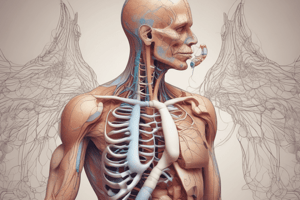Podcast
Questions and Answers
What percentage of CO2 in the blood is carried as dissolved CO2 in the plasma?
What percentage of CO2 in the blood is carried as dissolved CO2 in the plasma?
- 20%
- 50%
- 10% (correct)
- 30%
What enzyme catalyzes the reaction of CO2 with water to form carbonic acid?
What enzyme catalyzes the reaction of CO2 with water to form carbonic acid?
- Hydrogenase
- Hemoglobin
- Oxygenase
- Carbonic anhydrase (correct)
What is the result of the high PCO2 found in the capillaries of the systemic circulation?
What is the result of the high PCO2 found in the capillaries of the systemic circulation?
- Favours the formation of carbonic acid (correct)
- Favours the unloading of oxygen
- Favours the dissociation of carbonic acid
- Favours the loading of oxygen
What is the result of the binding of H+ to hemoglobin?
What is the result of the binding of H+ to hemoglobin?
What is the result of the chloride shift?
What is the result of the chloride shift?
What is the result of the 'trapping' of hydrogen ions within the red blood cells?
What is the result of the 'trapping' of hydrogen ions within the red blood cells?
Flashcards are hidden until you start studying
Study Notes
Carbon Dioxide Transport in the Blood
- Carbon dioxide is carried by the blood in three forms: dissolved CO2 in the plasma (10%), carbaminohemoglobin (20%), and bicarbonate ion (70%).
- Carbon dioxide combines with water to form carbonic acid, a reaction that occurs spontaneously in the plasma at a slow rate.
- Within the red blood cells, the enzyme carbonic anhydrase catalyzes the formation of carbonic acid, making it occur more rapidly.
Formation of Carbonic Acid and Bicarbonate
- The formation of carbonic acid from CO2 and water is favored by the high PCO2 found in the capillaries of the systemic circulation.
- The build-up of carbonic acid concentrations within the red blood cells favors the dissociation of these molecules into hydrogen ions and bicarbonate.
Buffering of Hydrogen Ions
- Hydrogen ions (H+) released by the dissociation of carbonic acid are combined with hemoglobin in the red blood cells, and HCO3- is released into the blood plasma.
- Binding of H+ to hemoglobin favors the unloading of oxygen, as deoxyhemoglobin binds to H+ more strongly than does oxyhemoglobin.
The Chloride Shift
- Bicarbonate diffuses outward into the plasma more than does H+.
- The "trapping" of hydrogen ions within the red blood cells by their attachment to hemoglobin and the outward diffusion of bicarbonate result in a net positive charge inside the red blood cell.
- This attracts chloride ions (Cl-), which move into the red blood cells as HCO3- moves out.
- This exchange of anions as blood travels through the tissue capillaries is called the chloride shift.
Studying That Suits You
Use AI to generate personalized quizzes and flashcards to suit your learning preferences.




